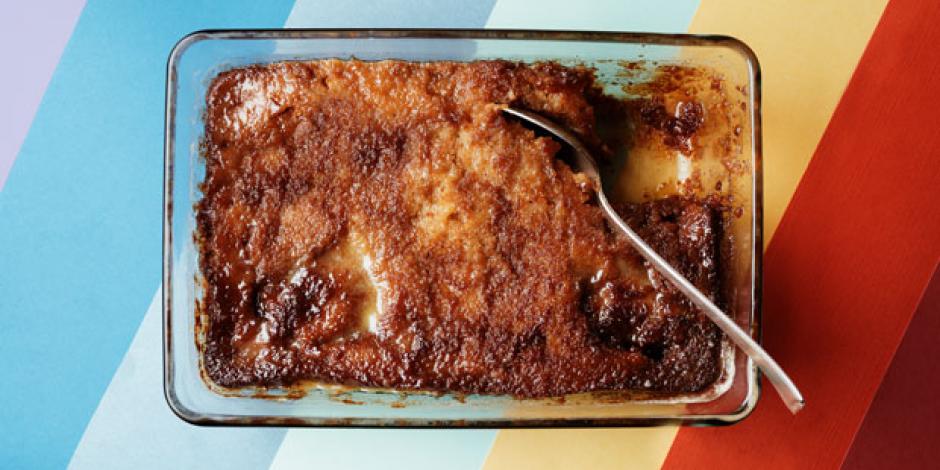Comfort in cake form: this simple sponge, soaked in a sweet, buttery cream, is the perfect way to finish Sunday dinner, leaving you with a warm glowGlühenglow in the bellyBauchbelly that will last right up to bedtime.
Malva’s origins are mysterious, but it’s as South African as, well, Nelson Mandela. Indeed, when the lateder, die verstorbene ...the late statesman’s personal chef, Xoliswa Ndoyiya, created a book of Mandela’s favourite recipes, malva pudding was one of the highlights.
The anti-apartheid revolutionary would insist that the children around him ate fruit for dessert. But as Ndoyiya told the New York Daily News in 2012, whenever she served up malva, Mandela simply couldn’t resist.
The pudding holds a nostalgic appealReizappeal for many South Africans, although it seems to have become popular as late as the 1980s. It owes its rise to a chef called Maggie Pepler, who came from a farming community in the Western Cape province.
Talented, yet modestbescheidenmodest, Pepler became a chef after her husband died in the 1960s. She made a late career cooking for South Africa’s ambassadorBotschafter(in)ambassadors to London and Paris. By the mid-1970s, she was working at one of South Africa’s best hotels.
In the old days, farmers’ wives knew it as telefoonpoeding (telephone pudding) because they would call each other to get the recipe
There, she happened to make some malva for the buffet. The head chef was blown away by the simple, scrumptious (ifml.)leckerscrumptious pud (pudding) (UK, ifml.)Nachtischpud. Before long, he moved Pepler to the legendary restaurant of the Boschendal, one of the country’s oldest wine estateAnwesen; hier: Weingutestates, where she taught staffPersonalstaff how to make malva. Former US secretary of state (US)Außenminister(in)Secretary of State Henry Kissinger reportedlyangeblich, Berichten zufolgereportedly loved it.
Before too long, malva was appearing in restaurants all over South Africa. Pepler, who died in 2013 at the age of 87, said she had been given the recipe by her mother. In the old days, farmers’ wives knew it as telefoonpoeding (telephone pudding) because they would call each other to get the recipe.
Undoubtedly, the pudding has an element of symbolism about it. In a country historically troubled by racial divisions, malva has been a unifyingvereinendunifying factor, bringing people together across the spectrum. In many ways, it’s the pudding of the rainbow nation, as archbishopErzbischofArchbishop Desmond Tutu described South Africa after the first fully democratic election in 1994.
To get back to basics, though, malva is quite simply a winning pud. A large part of its attraction comes from its lovely textureBeschaffenheit, Konsistenztexture. When the springyweich, elastischspringy sponge (UK)Biskuitkuchensponge, with its taste of apricot jam, is to soakeinweichen, durchtränkensoaked in the cream sauce, it forms a gooey (ifml.)klebrig, zähflüssiggooey pillowKissenpillow of sweetness that you’ll want to sink your spoon into again and again.
The recipe, presented here in its simplest form, is highly adaptablewandlungsfähigadaptable. Once you’ve mastered it, you could throw some choppedgehacktchopped dried apricots or toasted almondMandelalmonds into the mix. If, like me, you’re one of those people who tastes half the dish before it’s cooked, you might want to make some extra sauce. You’ve been warned!
Ingredients
Adapted from Maggie Pepler’s original recipe
For the sponge:
• 1 cup brown sugar (250 g)
• 1 egg
• 1 tablespoonEsslöffeltablespoon melted butter
• 1 tablespoon apricot jam
• 1 cup cake flour (125 g)
• 1 tablespoon bicarbonate of sodaBacksoda, Natronbicarbonate of soda
• 1 cup milk (250 ml)
• 1 tablespoon vinegarEssigvinegar
• a few drops of vanilla extract
For the sauce:
• 1 cup cream (250 ml)
• ½ cup milk (125 ml)
• ½ cup butter (125 g)
• 3 tablespoons golden syrup (UK)heller Zuckerrübensirupgolden syrup or half cup brown sugar (125 g)
Instructions
Preheat the oven to 180 °C (350 °F). Beat the sugar, egg, butter and jam to form a fluffylockerfluffy paste.
Mix the cake flourKuchenmehlcake flour and bicarbonate of soda, and slowly add this to the paste, alternating with the milk, vinegar and vanilla. to pourgießenPour into a baking dishBackformbaking dish (size: 30 x 20 x 5 cm), cover with foil(Aluminium)Foliefoil and bake for 40–45 minutes, testing with a knife to make sure the centre of the pudding is properly done.
When nearly finished, mix the ingredients for the sauce and allow them to cook slowly in a saucepanKochtopfsaucepan. Pour the sauce over the pudding. Eat while hot.
Neugierig auf mehr?
Dann nutzen Sie die Möglichkeit und stellen Sie sich Ihr optimales Abo ganz nach Ihren Wünschen zusammen.



